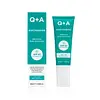What's inside
What's inside
 Key Ingredients
Key Ingredients

 Benefits
Benefits

 Concerns
Concerns

 Ingredients Side-by-side
Ingredients Side-by-side

Water
Skin ConditioningDicaprylyl Carbonate
EmollientMethylene Bis-Benzotriazolyl Tetramethylbutylphenol
UV FilterOctocrylene
UV AbsorberEthylhexyl Salicylate
UV AbsorberEthylhexyl Triazone
UV AbsorberPolymethyl Methacrylate
Butyl Methoxydibenzoylmethane
UV AbsorberBis-Ethylhexyloxyphenol Methoxyphenyl Triazine
Skin ConditioningTriacontanyl Pvp
HumectantDecyl Glucoside
CleansingC20-22 Alkyl Phosphate
EmulsifyingC20-22 Alcohols
Emulsion StabilisingPhenoxyethanol
PreservativePotassium Cetyl Phosphate
EmulsifyingGlycerin
HumectantButylene Glycol
HumectantGlucose
HumectantChlorphenesin
AntimicrobialTetrasodium EDTA
Xanthan Gum
EmulsifyingHydrogenated Polydecene
EmollientO-Cymen-5-Ol
AntimicrobialTocopheryl Acetate
AntioxidantPropylene Glycol
HumectantTrehalose
HumectantCitric Acid
BufferingSodium Hydroxide
BufferingAscorbyl Tetraisopalmitate
AntioxidantTocopherol
AntioxidantSpirulina Platensis Extract
Skin ProtectingPolyquaternium-51
Skin ConditioningWater, Dicaprylyl Carbonate, Methylene Bis-Benzotriazolyl Tetramethylbutylphenol, Octocrylene, Ethylhexyl Salicylate, Ethylhexyl Triazone, Polymethyl Methacrylate, Butyl Methoxydibenzoylmethane, Bis-Ethylhexyloxyphenol Methoxyphenyl Triazine, Triacontanyl Pvp, Decyl Glucoside, C20-22 Alkyl Phosphate, C20-22 Alcohols, Phenoxyethanol, Potassium Cetyl Phosphate, Glycerin, Butylene Glycol, Glucose, Chlorphenesin, Tetrasodium EDTA, Xanthan Gum, Hydrogenated Polydecene, O-Cymen-5-Ol, Tocopheryl Acetate, Propylene Glycol, Trehalose, Citric Acid, Sodium Hydroxide, Ascorbyl Tetraisopalmitate, Tocopherol, Spirulina Platensis Extract, Polyquaternium-51
Water
Skin ConditioningAloe Barbadensis Leaf Juice
Skin ConditioningPropanediol
SolventNiacinamide
SmoothingC12-15 Alkyl Benzoate
AntimicrobialTitanium Dioxide
Cosmetic ColorantCaprylic/Capric Triglyceride
MaskingDiethylamino Hydroxybenzoyl Hexyl Benzoate
UV FilterArginine
MaskingGlycerin
HumectantBetaine
HumectantAllantoin
Skin ConditioningLonicera Caprifolium Flower Extract
PerfumingLonicera Japonica Flower Extract
Skin ConditioningEthylhexyl Triazone
UV AbsorberBis-Ethylhexyloxyphenol Methoxyphenyl Triazine
Skin ConditioningCarbomer
Emulsion StabilisingLecithin
EmollientJojoba Esters
EmollientCaprylyl Glycol
EmollientPolyhydroxystearic Acid
EmulsifyingHydroxyacetophenone
AntioxidantPhenoxyethanol
PreservativeStearic Acid
CleansingCitric Acid
BufferingWater, Aloe Barbadensis Leaf Juice, Propanediol, Niacinamide, C12-15 Alkyl Benzoate, Titanium Dioxide, Caprylic/Capric Triglyceride, Diethylamino Hydroxybenzoyl Hexyl Benzoate, Arginine, Glycerin, Betaine, Allantoin, Lonicera Caprifolium Flower Extract, Lonicera Japonica Flower Extract, Ethylhexyl Triazone, Bis-Ethylhexyloxyphenol Methoxyphenyl Triazine, Carbomer, Lecithin, Jojoba Esters, Caprylyl Glycol, Polyhydroxystearic Acid, Hydroxyacetophenone, Phenoxyethanol, Stearic Acid, Citric Acid
 Reviews
Reviews

Ingredients Explained
These ingredients are found in both products.
Ingredients higher up in an ingredient list are typically present in a larger amount.
You might know this ingredient as Tinosorb S or Bemotrizinol. It is a UV filter that covers both UVA and UVB rays.
This ingredient has two peak UV absorption peaks ( 310 and 340 nm) and is able to absorb both UV-A and UV-B rays. This ingredient works by preventing UV rays from reaching and damaging your skin.
On top of that - it is highly photostable and helps prevent the photodegration of other sunscreen ingredients such as avobenzone.
Tinosorb S is allowed in the EU, Australia, and Asia. It is close to being approved by the FDA and we'll hopefully get this ingredient in the U.S. by late 2025.
Fun fact: Tinosorb S is the most effective UV absorber at maximum concentration (measured by SPF) permitted in the EU.
This ingredient is oil-soluble, so your oil-cleansers will take this right off at night.
Learn more about Bis-Ethylhexyloxyphenol Methoxyphenyl TriazineCitric Acid is an alpha hydroxy acid (AHA) naturally found in citrus fruits like oranges, lemons, and limes.
Like other AHAs, citric acid can exfoliate skin by breaking down the bonds that hold dead skin cells together. This helps reveal smoother and brighter skin underneath.
However, this exfoliating effect only happens at high concentrations (20%) which can be hard to find in cosmetic products.
Due to this, citric acid is usually included in small amounts as a pH adjuster. This helps keep products slightly more acidic and compatible with skin's natural pH.
In skincare formulas, citric acid can:
While it can provide some skin benefits, research shows lactic acid and glycolic acid are generally more effective and less irritating exfoliants.
Most citric acid used in skincare today is made by fermenting sugars (usually from molasses). This synthetic version is identical to the natural citrus form but easier to stabilize and use in formulations.
Read more about some other popular AHA's here:
Learn more about Citric AcidEthylhexyl Triazone is a modern chemical sunscreen that protects from UV-B radiation.
It is the most effective of existing UV-B filters, as it provides the highest level of photo-stable absorption. It protects from the entire UV-B range (280 to 320nm), with it's highest level of protection at 314nm.
Ethylhexyl Triazone is oil soluble, oderless and colorless, which mean it is able to be incorporated into a variety of different formulations.
It is not currently available within the United States due to slow changing FDA regulations. Outside of the US, it is used in formulations at concentrations up to 5%.
Learn more about Ethylhexyl TriazoneGlycerin is already naturally found in your skin. It helps moisturize and protect your skin.
A study from 2016 found glycerin to be more effective as a humectant than AHAs and hyaluronic acid.
As a humectant, it helps the skin stay hydrated by pulling moisture to your skin. The low molecular weight of glycerin allows it to pull moisture into the deeper layers of your skin.
Hydrated skin improves your skin barrier; Your skin barrier helps protect against irritants and bacteria.
Glycerin has also been found to have antimicrobial and antiviral properties. Due to these properties, glycerin is often used in wound and burn treatments.
In cosmetics, glycerin is usually derived from plants such as soybean or palm. However, it can also be sourced from animals, such as tallow or animal fat.
This ingredient is organic, colorless, odorless, and non-toxic.
Glycerin is the name for this ingredient in American English. British English uses Glycerol/Glycerine.
Learn more about GlycerinPhenoxyethanol is a preservative that has germicide, antimicrobial, and aromatic properties. Studies show that phenoxyethanol can prevent microbial growth. By itself, it has a scent that is similar to that of a rose.
It's often used in formulations along with Caprylyl Glycol to preserve the shelf life of products.
Water. It's the most common cosmetic ingredient of all. You'll usually see it at the top of ingredient lists, meaning that it makes up the largest part of the product.
So why is it so popular? Water most often acts as a solvent - this means that it helps dissolve other ingredients into the formulation.
You'll also recognize water as that liquid we all need to stay alive. If you see this, drink a glass of water. Stay hydrated!
Learn more about Water